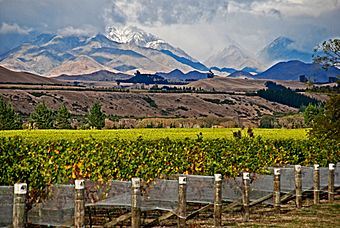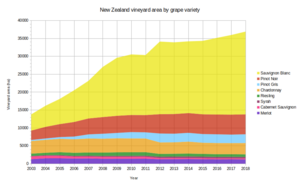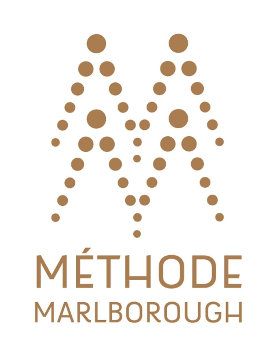Marlborough wine region facts for kids
The Marlborough wine region in New Zealand is super important for wine! It makes about three-quarters of all the wine in the country. This means it has most of New Zealand's grape farms, called vineyards.
It's a special area in the north-east of New Zealand's South Island. Most of the vineyards are near the towns of Blenheim and Seddon. Marlborough is famous around the world for its amazing Sauvignon Blanc wine. Many wine experts say it's the best in the world!
Contents
History of Marlborough Wine
Early Beginnings
People first planted grapevines in Marlborough way back in the 1870s. A man named David Herd planted some grapes in 1873. But by 1931, his son had removed the last of these vines. For the next 40 years, no one grew grapes for wine in the area.
Modern Wine-Making Starts
Serious wine-making began in 1973. This is when Montana Wines, a very big New Zealand company, planted large vineyards. Today, this company is called Brancott Estate.
In 1975, a French Champagne maker named Daniel Le Brun moved to New Zealand. He wanted to make sparkling wine in Marlborough using a special method.
Marlborough's Big Success
By the early 1980s, wineries in Marlborough were making fantastic Sauvignon Blanc. Then, in 1985, a wine from Cloudy Bay Vineyards became famous worldwide. This made people everywhere notice New Zealand wine.
Wine experts like George Taber and Oz Clarke said that New Zealand Sauvignon Blanc was "arguably the best in the world." Because Marlborough was so good for sparkling wines, big Champagne companies from France also started investing there.
Growing Sauvignon Blanc grapes really took off in the 2000s. This was mostly because of new investments in Marlborough. The area used for these grapes grew five times bigger in just 15 years!
Climate and Geography
Perfect Growing Conditions
The land in the Wairau Valley is great for growing grapes. It has special gravelly soil that lets water drain away easily. This valley is protected by hills on both sides, which keeps it safe from bad weather.
The weather is usually sunny and warm in summer and autumn. This gives the grapes a long time to grow and ripen. Cool breezes from the sea at night help the grapes develop their unique flavors.
Water and Hills
Sometimes it can be very dry, so younger grapevines need extra water. Many vineyards are on the flat valley floor. But some wineries are also growing grapes on sunny hillsides without extra watering, using special farming methods.
| Climate data for Blenheim (1981–2010) | |||||||||||||
|---|---|---|---|---|---|---|---|---|---|---|---|---|---|
| Month | Jan | Feb | Mar | Apr | May | Jun | Jul | Aug | Sep | Oct | Nov | Dec | Year |
| Mean daily maximum °C (°F) | 24.1 (75.4) |
23.8 (74.8) |
21.9 (71.4) |
19.0 (66.2) |
16.0 (60.8) |
13.3 (55.9) |
12.6 (54.7) |
13.8 (56.8) |
15.8 (60.4) |
18.0 (64.4) |
20.0 (68.0) |
22.2 (72.0) |
18.4 (65.1) |
| Daily mean °C (°F) | 18.0 (64.4) |
17.6 (63.7) |
15.8 (60.4) |
13.0 (55.4) |
10.2 (50.4) |
7.7 (45.9) |
7.0 (44.6) |
8.2 (46.8) |
10.3 (50.5) |
12.2 (54.0) |
14.2 (57.6) |
16.5 (61.7) |
12.6 (54.7) |
| Mean daily minimum °C (°F) | 11.8 (53.2) |
11.5 (52.7) |
9.8 (49.6) |
6.9 (44.4) |
4.5 (40.1) |
2.2 (36.0) |
1.5 (34.7) |
2.6 (36.7) |
4.7 (40.5) |
6.5 (43.7) |
8.4 (47.1) |
10.8 (51.4) |
6.8 (44.2) |
| Average precipitation mm (inches) | 48.9 (1.93) |
49.4 (1.94) |
46.5 (1.83) |
52.7 (2.07) |
60.6 (2.39) |
70.7 (2.78) |
74.3 (2.93) |
62.2 (2.45) |
65.2 (2.57) |
67.4 (2.65) |
55.0 (2.17) |
58.1 (2.29) |
711.0 (27.99) |
| Average precipitation days (≥ 1.0 mm) | 5.0 | 5.1 | 5.5 | 5.3 | 6.7 | 7.9 | 7.6 | 8.0 | 8.5 | 8.3 | 6.9 | 6.7 | 81.5 |
| Average relative humidity (%) | 68.7 | 74.2 | 74.9 | 77.5 | 81.5 | 82.3 | 83.7 | 80.8 | 73.3 | 72.1 | 67.7 | 67.5 | 75.4 |
| Mean monthly sunshine hours | 262.2 | 223.7 | 230.8 | 193.7 | 172.7 | 151.6 | 157.1 | 183.9 | 189.5 | 226.7 | 234.7 | 248.8 | 2,475.3 |
| Source: NIWA Climate Data | |||||||||||||
Main Sub-regions
Marlborough has three main areas where grapes are grown.
Wairau Valley
This is the flat river area around the town of Blenheim. It has deep, gravelly soils from the river.
Southern Valleys
These valleys are to the south. They include the sunny hillsides of the Wither Hills. The soil here is mostly made of fine dust called loess.
Awatere Valley
This area is to the south-east, near the town of Seddon. It's generally a bit cooler than the other areas. About one-third of all Marlborough's vineyards are in the Awatere Valley.
Protecting Marlborough Wines
Special Rules for Wine
In 2018, Marlborough became a special "geographical indication" (GI) area. This means wines from here have to meet certain rules. It's like a special label that shows where the wine comes from.
Some wineries in Marlborough also created a group called Appellation Marlborough Wine. This group helps make sure Marlborough wines are always high quality. To get their special certification, wines must:
- Be made only from grapes grown in Marlborough.
- Use grapes grown in a way that is good for the environment.
- Follow rules about how many grapes can be grown each year.
- Be bottled in New Zealand.
Sparkling Wines
Marlborough also makes a lot of sparkling wine using a traditional method. This method uses Chardonnay and Pinot Noir grapes. Big Champagne companies like Mumm and Moët & Chandon have invested in Marlborough because of this.
In 2013, several Marlborough sparkling wine makers formed Méthode Marlborough. This group works together to make sure their sparkling wines are excellent and well-known around the world.
Images for kids





